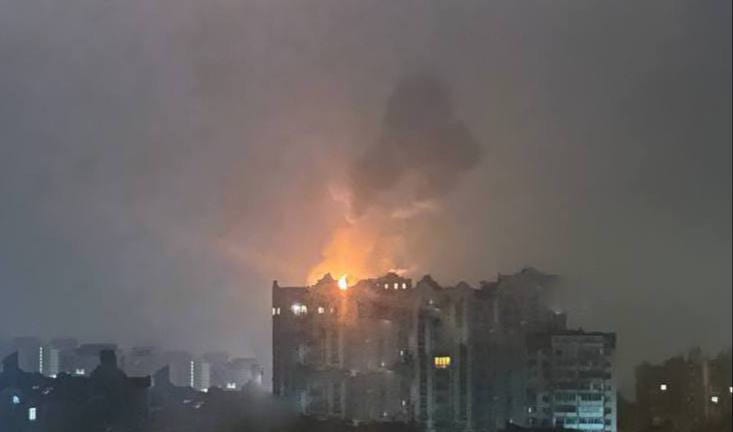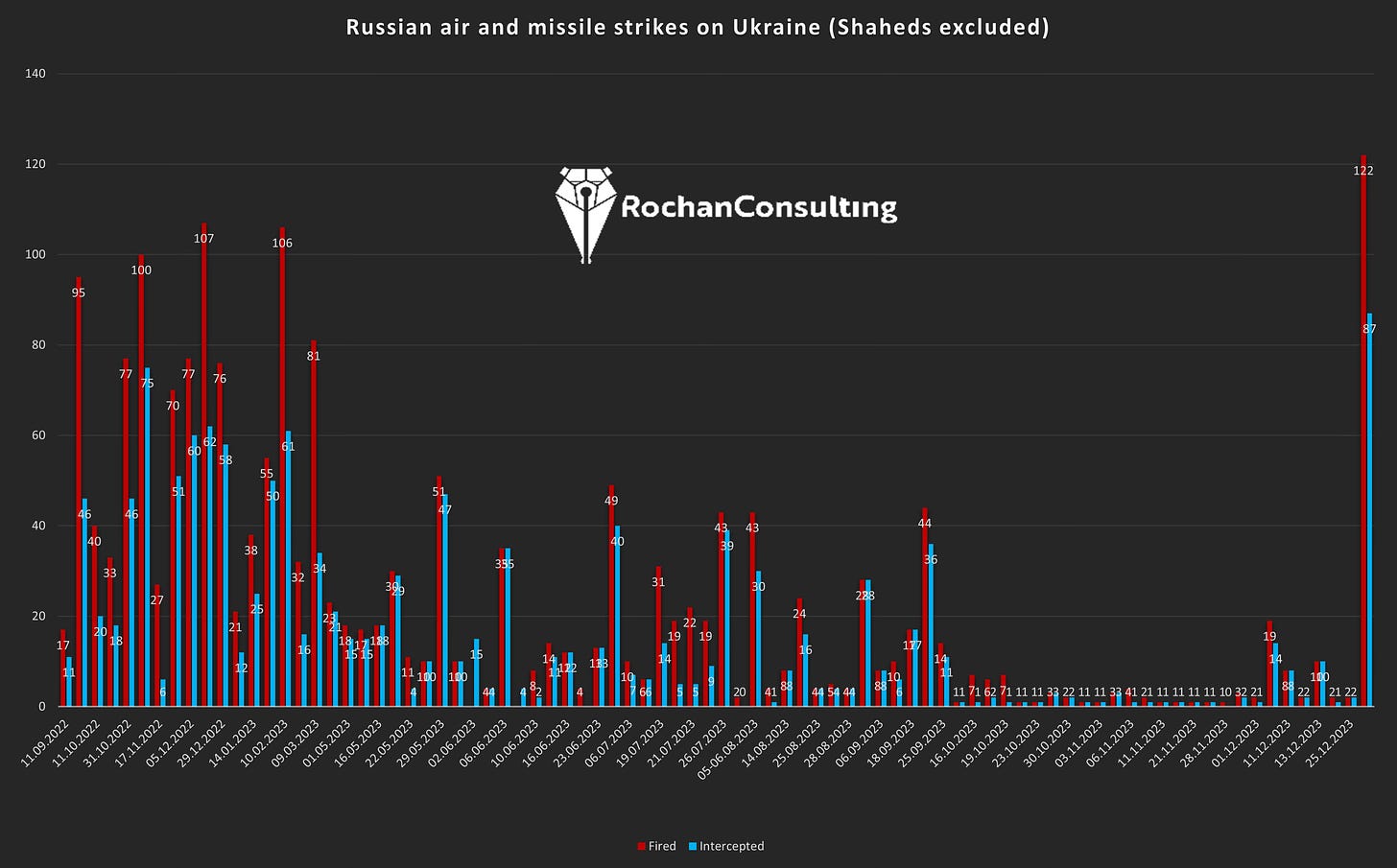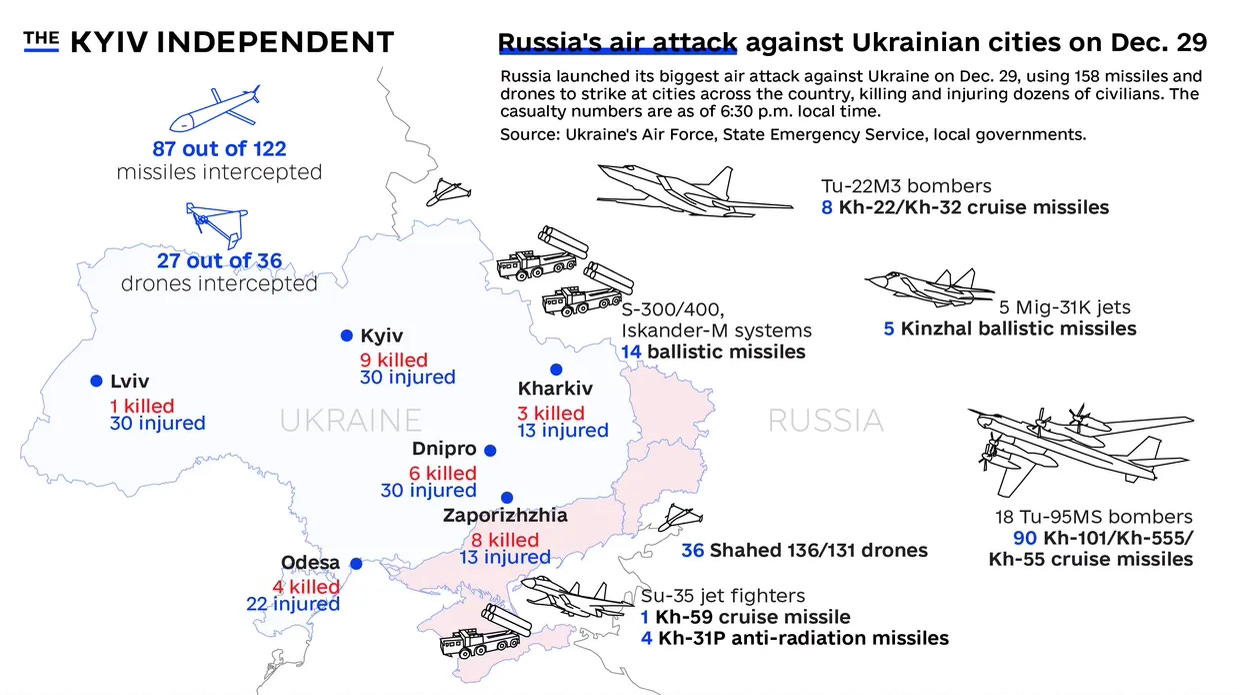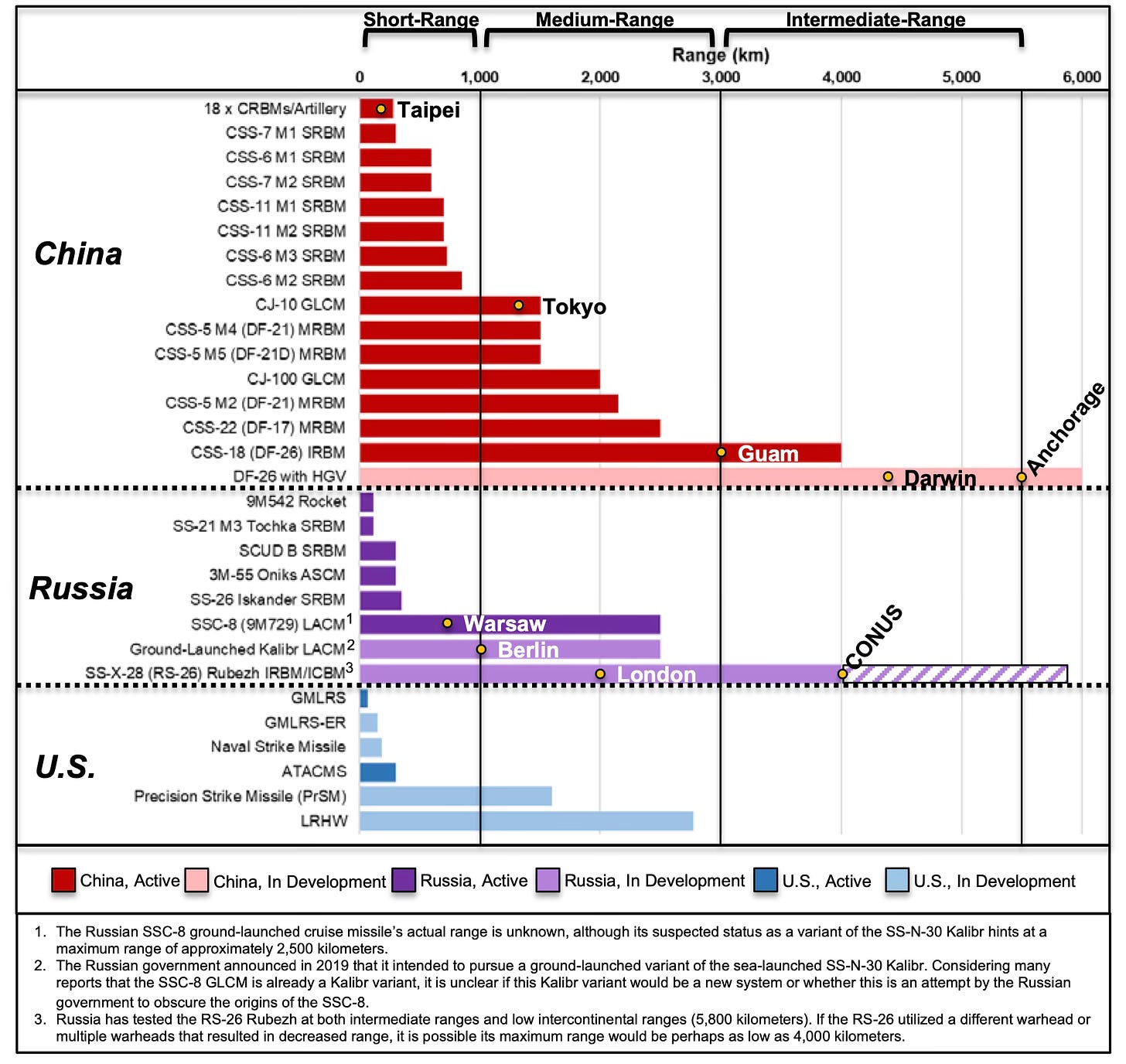MICK RYAN

A shocking series of Russian massed missile and drone attacks occurred across Ukraine in the past 48 hours. According to Ukrainian government reports, 158 Russian missiles and drones attacked targets in multiple Ukrainian cities including Kyiv, Odesa, Dnipro, Lviv and other locations. Over 30 people were killed and at least 150 injured.
According to the tally of air and missile strikes maintained by Rochan Consulting since the beginning of the Russian large-scale invasion in 2022, this is the largest series of attacks that has taken place. While it has been clear for some time (see graph below) that the Russians have been hording missiles for their winter campaign, it is uncertain whether the 29 December attacks were a one-off surge, or the start of an enhanced Russian winter strike campaign.
Source: Rochan Consulting
What does Putin & Russia aim to achieve by continuing to conduct such attacks, and what do the attacks tell us about the coercive power of strategic air, missile, and drone attacks?
Russian Objectives
The Russian attacks, which have occurred throughout the war, have multiple objectives.
At its most simple, these Russian air, missile and drone attacks are a bigger and more complex version of the attacks on civilian infrastructure that Russia appears to have mastered during this war. The attacks are conducted to terrorize civilians and to degrade civilian morale.
But these attacks are also aimed at responding to the last couple of weeks successes by the Ukrainians. Russian fighter bombers have been shot down in air defence ambushes. Russian naval vessels have been attacked, with the most spectacular being the destruction of the Ropucha class Landing Ship Tank (LST) Novocherkassk. The ship, berthed alongside in the port of Feodosia on the southern coast of Russian-occupied Crimea, was destroyed by a Ukrainian missile strike.
The secondary explosions indicate that the ship was carrying explosive ordnance (possibly armed drones). Russian commander, General Gerasimov, knows this hurts Russian prestige and would have been keen to strike back at the Ukrainians.
Another Russian objective for the 29 December air, missile and drone attacks will have been to test the limits of the air defence system developed by Ukraine over the past 18 months. This air defence network, a mesh of Western, Soviet-era and commercial launchers, missiles, C2, sensors and reporting systems is now much more capable than it was this time in 2022. The Russians will have been testing to see if this air defence network could be overwhelmed, or at least, where there are exploitable weaknesses. The adaptation battle continues.
Source: The Kyiv Independent
But the Russians will not only be testing the capacity of this evolving air, missile and drone defence system. They will be testing Ukraine’s ‘magazine depth’ and hoping that Ukraine runs out of interceptors before Russia runs out of missiles and drones. The announcement by the British Government that it would provide more air defence missiles to Ukraine will be very welcome, as is the latest U.S. military assistance package which also included air defence missiles.
Perhaps the most important Russian objective of this attack, and other air and missile strikes, is to create additional leverage for Russia to freeze the conflict. This would provide time and space for Russian forces, particularly ground forces, to reconstitute before continuing his campaign to destroy Ukraine. And it would also draw out the conflict, something that Putin clearly believes is in his interest to do.
Putin has made clear again recently that he has not changed his overall objective to subjugate Ukraine. At his recent 2023 press conference, he described how:
Almost along the entire front line, our armed forces, let's put it modestly, are improving their position. There will be peace when we achieve our goals.
To do this, he requires a pause to rebuild the combat power of the Russian Army. He will not do this if the Russian Army continues its current investment in multiple offensives, which are generating large Russian casualties but seizing minimal territory. But, given the March 2024 Russian elections, it is likely Putin will continue these attacks until after the election and only then permit some kind of pause to reconstitute Russian forces.
For the Russians, the attacks are also a key part of their domestic and global influence operations. The attacks demonstrate Russian ‘strength’ to the Russian people in the lead up to the March elections. They are also designed to show to an international audience, particularly Western politicians and citizens, that a Russian victory is inevitable. This aims to (hopefully) convince Ukraine and the West to negotiate.
But we have not reached this point. The resilience of Ukrainian people, and the efforts of the Ukrainian Armed Forces (in cooperation with NATO and their Western supporters) to create a world-class air, missile and drone defence network, has provided political and military foundations to resist Russia’s strategic coercion and terrorism.
But the West needs to step up its support in 2024. And, the US and NATO must evolve their strategy from helping Ukraine defend itself, to helping Ukraine defeat Russia.
Lessons for Other Theatres
There are lessons from these Russia air, missile, and drone attacks for other theatres.
In particular, the possession of an advanced precision strike system, including large missile and drone stocks and a sophisticated supporting ISR network, provides an incredible tool for strategic and political coercion. It permits nations to be able to apply a balance of destruction and influence operations in order to achieve their national objectives.
Currently, the bar to developing such a capacity is lower than ever. Meshed civ-mil sensor networks are relatively cheap. Lethal autonomous systems, in the air and maritime domains, with long range have proliferated globally and are available to both government and non-government entities.
The Houthis, with their ongoing campaign of long-range missile launches towards Israel, and drone and missile strikes against ships in the Red Seas are demonstrating how non-state actors can assemble and use precision, long-range strike complexes. In 2024, we may also see Hezbollah use its long-range strike capability against Israel (although I hope this does not eventuate).
China also understands well the capability provided by a long-range sensor and strike complex. They have spent decades building a huge missile force that is, first and foremost, designed to project an air of inevitable destruction of its adversaries in the event of a conflict. A quick comparison of Chinese conventional missile capabilities, compared to Russia and the U.S. capabilities, is shown below. It is taken from a recent report by the Center for Strategic and Budgetary Assessments that explores theatre conventional missiles in the Indo-Pacific.
While ultimately a military tool of both tactical and theatre utility, this missile force is also one that can be used to coerce neighbours - and even the U.S. - into accepting Chinese goals and denying interference in what they view as ‘their region’ (the Western Pacific). The People’s Liberation Army (PLA) missile arsenal is part of China’s ‘win without fighting’ approach. This also complements some of their other strategic coercion tools: economic coercion, misinformation, and paying off politicians and officials across the Indo-Pacific.
Thus, there is an imperative to continue learning from how Ukraine has constructed their air, missile and drone defence network. It is a sophisticated mash up of different systems with high interception rates. Countries in Asia, Oceania and Europe will need to improve their air, missile and drone defences in the coming years, and the lessons from Ukraine should at least inform these developments.
The better these nations are at air, missile, and drone defence, the less coercive power that is handed to Authoritarian Quad of Russia, China, Iran and North Korea. These nations have been developing their capabilities for decades, and it will take time to develop counters.
It bears stating too that air, missile, and drone defence isn’t just about defence through ‘defensive’ capacity. Long range precision strike to degrade enemy ISR, launch and production capacity is also required to deprive the Authoritarian Quad their strategic coercion capacity and warfighting capabilities.
Ukraine, which had a limited ability to strike back last winter, is now demonstrating both the will and capacity to do so. Within 24 hours of Russia’s large scale strikes across Ukraine, strikes were apparently conducted against military and industrial targets in the Bryansk, Orel, Kursk, and Moscow regions.
One Off or Beginning of a Surge: The Russian Strikes are Part of Modern War
The massed Russian attacks yesterday are not just a demonstration of Ukrainian resilience or Russian barbarity. They should provide a driver for more assistance to Ukraine, for their air defence, and for their strategic strikes against Russia’s missile launch and production capacity.
And, rather than succumb to ‘war fatigue’ (although I am not sure what the citizens in the West have to be fatigued about), it should drive a reinvigoration among Western polities of support for Ukraine.
But these Russian strikes against Ukraine are also a lesson for the West (again) on the importance of robust air, missile and drone defence systems. These systems are important to protect battlefield operations. But they are also vital to deny authoritarians the wherewithal to use their air, missile and drone attack capabilities for political and diplomatic coercion.



No comments:
Post a Comment